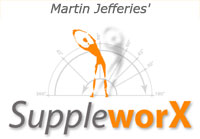
Muscle & Joint problems
Injury Rehabilitation & Performance Enhancement Prehabilitation
|
|
||
|
|
||
 |
||
|
|
||
“the exercises you gave me were the complete opposite of what the physiotherapist told me to do. Your stuff worked” – Rory O, London Muscle problems: If your muscles are tight (closed and stuck), overused (strained and tired) or broken (broken), you have a problem. If they are completely broken (detached) then you need surgery. If they’re not completely broken, I can help. Muscles that become tight or stuck have not shrunk as they would perhaps do if you put them in a microwave oven. They have simply learned to stay in a partially closed position, either because you keep holding them in a partly closed position (nerve programming) or because one of the joints they attach to is under stress and does not want to move through it’s full range (secondary splinting). Fixing them is simply a matter of mobilizing and stabilizing the joint, making the muscle more pliant and comfortable then reprogramming the nerves that control both. We then need to identify what you did that caused it, eliminate or modify that and give you some exercises to complete the process. Simple really! Overused muscles will break down internally and need realigning. Uncomfortable/painful but effective if done properly and with a modicum of mercy! IMPORTANT – A damaged muscle or joint will NOT be made better by taking it to a gym where you do exercises that inflict more damage in a vain attempt to make it stronger. Stronger does not automatically mean better and is not a means of making a damaged muscle work. If your muscles are short (stuck) they cannot function properly and will loose power. They will also probably be compressing one of the joints they attach to which causes secondary contraction to stabilize the joint. This equals more compression, tighter muscles and more pain. Any one who sends you away with strengthening exercises for short muscles and/or painful joints needs their heads testing (in my humble opinion). "It’s only thanks to Martin that I’ve been able to continue skiing (or even walking!) for so long despite an osteoarthritic hip. He really does have an extraordinary gift of healing"- Peter W, a gentleman and a skier Joint problems: If a joint is causing you pain there are a number of possible causes. If the joint has lost movement, there is a possibility or nerve compression in an area of the spine. I can often manipulate and mobilize the appropriate area to release it but usually prefer to refer clients to one of my favoured osteopaths for this part of treatment. There is also the possibility of ligament damage. Ligaments are effectively straps that hold the ends of bones in a joint together. If you over extend (stretch) the ligaments they will break. Sometimes a little, sometimes a lot. Either way they will take some weeks to recover but will fire up supporting muscles to help splint the joint whilst it recovers. This secondary reaction is usually overkill and actually causes more harm than good for most people. Treatment is similar to that for tight muscles described above.
Injury rehabilitation: The problem with most injuries is that they don’t get rehabilitated. Firstly, the muscle that is originally injured has usually fixed itself (as in repaired the damaged fibres) by the time you see anyone with it. The ongoing problem stems mainly from the secondary contraction in surrounding muscles. Whilst the original injury site could do with a bit of re-training, the surrounding muscles can be holding on like grim death long after the flashing lights should have died down, causing more joint compression and pain and giving the impression that the original injury still exists. Treatment varies but mainly consist of mobilising the injury site and addressing muscle tension in areas radiating from it. Sadly, the true rehabilitation work (as in re-training) is your bit, but you will get the best possible guidance. The effected muscles and the joint/s they support need to be gradually coerced into their full range of movement and effectively reassured that they can look after themselves and function correctly again. This can be a lot faster than you’d think and consists of such unlikely techniques as putting the injured area into exactly the situation that caused the injury, just differently!
Performance enhancement – prehabilitation: If you are pushing your body in training it will break down. That doesn’t mean that it breaks, simply that as part of the process of improving the performance of a given muscle, you have to push it to exhaustion at which point your body fires up new muscle fibers. The old fibers repair and the muscle is stronger. Massage alone will realign damaged fibers so that you recover faster and can train harder for improved performance. An equally important but often overlooked part of this work (particularly as a means of injury prevention) is passive joint mobilizing. The joints need to be pushed up to and beyond their current limits without stressing them, then the muscles can be quickly trained to recognize and control the full range of motion functionally. All the components are reasonably straightforward but what is often missing is an understanding of the anchoring mechanisms which tie muscles together and literally block movement and waste energy. Doing the other work but missing this element is like having your car engine race tuned then driving it around with the handbrake on! I have done this type of work with many people whilst training for specific events and with a few on an ongoing basis as part of their training regime. I do not work with professional athletes and can think of nothing more dull than continually fixing the same person just so that they can go out and break themselves again! |